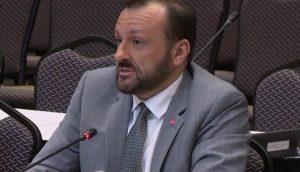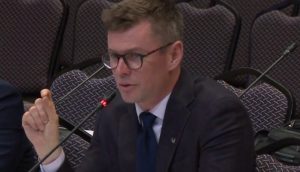The latest awareness campaign by Kids Help Phone is utilizing immersive technology to show that teens’ lives aren’t always what they seem.
A photo post that went live on the organization’s page Nov. 14 appeared to show a young female student smiling for the camera. However, when users panned around on their desktop or mobile devices, the image was revealed to be a 360 post, and outside the frame, other students are seen whispering and mocking the girl, with some scrawling insults on a nearby wall. The post was timed with Ontario’s Bullying Awareness Week, which was from November 14 to 18.
It was the organization’s first time using the immersive medium, and Melanie Simons, head of marketing and communications for Kids Help Phone, said the aim was to create a message that stopped social media users in their track without even saying a word.
“We wanted to really try a new approach and develop something that was immersive for audiences and tell a story in a deeper way,” she told MiC. “You can do that through video, but we wanted to try something more innovative.”
The campaign targets both the young teen and tween crowds and their parents, with two unique posts created (one for young adults age 13 to 24, which read “Share with us what you can’t share with anyone else,” and one for adults older than 25 with the message “Kids share with us what they can’t share with anyone else”).
According to numbers provided by Society, Etc (which executed the media buy pro-bono for the campaign), the post directed at people 25 and older generated 240,000 impressions, with 3,800 reactions, 300 comments and 950 shares, with a 4% unique engagement rate from Canadians through paid and earned media.
The ad for yound adults generated 220,000 impressions, with 2,200 reactions, 200 comments and 300 shares, with a 4.5% unique engagement rate.
“I think it really struck a chord. We’ve been able to see comments on the post about parents whose kids have been bullied, or even who had been bullied themselves,” said Simons.
Creative for the campaign was executed by JWT. Facebook also partially sponsored the boosting of the posts.
Simons said the era of social and digital media has allowed the organization to become far more creative with its campaigns.
“The targeting capabilities [of Facebook] are incredible,” she said, adding that the target for this campaign was aimed at both the teen audience and parents of teens. “We have a better way of ensuring that our messages are getting seen by the right people.”
The challenge, she said, is that social media brings about an onslaught of branded messaging to teens — not all of it positive — and the organization has to work harder to stand out.
In the past two years, Kids Help Phone has grown its audience on Facebook from 6,000 to 24,000 likes (English page) and 1,500 to 6,000 likes (French page). Simons credits this growth to Kids Help Phone’s increased Facebook-native content investing more in paid advertising campaigns, although she wouldn’t speak to the specific increase of the ad spend.
Last year, the organization ran a digital campaign entitled “Find Your Voice” which aimed to engage more young people and raise awareness of the organization, and followed up with its “BroTalk” campaign, which targeted male youth in need of counselling services who are statistically less likely to reach out for help.
Simons said both campaigns were viewed as successes by Kids Help Phone, with the Find Your Voice campaign pulling in more than 160,000 engagements (likes, shares, comments) and increasing the organizations’ Instagram audience by 244%, and resulting in a 35% increase to the connection to the service. Similarly, the BroTalk campaign, which ran for 12 weeks on Facebook, Instagram and Xbox, resulted in 65,000 website sessions, almost 2,000 contacts to the service and 600 counselling sessions.
According to Simons, another post will launch in December on a different topic that teens can identify with, although she wouldn’t reveal the topic to MiC.
























